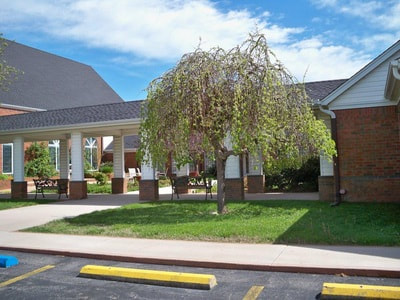|
Ozark Green Thumb BCMG Monthly e-Newsletter |
|
|
|
JANUARY GARDEN CHECKLIST
County Extension Agent Telephone: 425-2335
0 Comments
First Presbyterian Church, 1106 Spring Street, Mountain Home
Master Gardener's are a fun group of folks and enjoy sharing our love of gardening with any visitor. At our meeting we have speakers, refreshments, & fun. Come join us at one of our meetings. Meeting Dates: January 11th. from 1:00 - 3:00 pm Meeting Place: The First Presbyterian Church 1106 Spring Street Mountain Home, AR January Speaker: Jane and Frits Druff will speak on their trip to the Oregon International Conference last year. Master Gardeners Monthly Radio Program: Mountain Talk Radio Jan. 18th on 97.1 7:15 a.m. - 8:am. Master Gardener Host this month is Tommy Hagan New 2018 Board Members President Frank Sinning Past President/Advisor Phyllis Henley VP-Susan Chamberlain Membership Coordinator VP-Penny Wells Gardens Coordinator VP-Ceil Gaseicki Public Events Coordinator Treasure Marcia Taylor Secretary Carol Babsky and Judy Brieske MAL (Member at Large) Kathy Gilmore NMAL (New Member at Large) James Weigand Directions: From Mountain Home Take US Hwy. 62B East through Mountain Home until you come to Cardinal Street. Cardinal Street is the intersection just past Harp's Grocery. Turn right onto Cardinal Street and travel South until you come to the first stop sign which should be Spring Street. Turn left onto Spring Street and go down the hill past the bridge and the First Presbyterian Church will be on your right hand side. From Gassville: Take Hwy. 62/412 towards Mountain Home. Once you get to Mountain Home continue on into Mountain Home on US 62B. This will take you through town till you get to Harp's Grocery and you come to Cardinal Street. Cardinal Street is the intersection just past Harp's Grocery. Turn right onto Cardinal Street and travel South until you come to the first stop sign which should be Spring Street. Turn left onto Spring Street and go down the hill past the bridge and the First Presbyterian Church will be on your right hand side. 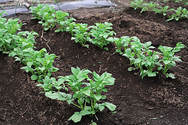 Winter is a good time to start planning your spring vegetable garden. These are some things to consider. Many factors should be considered when selecting the garden site. The size of the garden is determined by the available space, the number of members in the family and how the vegetables will be used. Sunlight is essential to plant growth. Vegetables should receive a minimum of six hours of direct sunlight during the day. Tomatoes, corn, peppers, cucumbers, root crops and melons need full sunlight. Some of the leafy vegetables like cabbage, broccoli and cauliflower will tolerate more shade. The roots of trees, large shrubs and hedges compete with vegetables for nutrients and moisture. Additional plant food and extra water help compensate for this competition but will not relieve shade problems. Surface drainage of excessive rains is desirable. Using slightly sloping areas helps, and areas that are more sloped may be used if managed properly. Contour the rows to the shape of the slope (plant around the hill). You can construct terraces or raised beds if the slope is too steep. A soil test can make the difference between success and failure in the garden. Soil testing is a free service provided by the Cooperative Extension Service and the Soil Testing Laboratory. Soil tests are desirable to determine the pH level and the amount of nitrogen, phosphorus, potassium and calcium in the garden’s soil. They are helpful if the samples are taken properly and the recommendations followed. Your county Extension office has instructions and containers for submitting the samples. The pH of the soil can be adjusted to make sure that soil nutrients are available. Most native soils in Arkansas are acidic and need to be amended with lime to raise the soil pH. The vegetable garden should be slightly acidic with a pH level ranging from 5.8 to 6.8. Lime takes 6 to 8 weeks to alter soil pH and should be applied in the fall or late winter. Agricultural lime has a mix of particle sizes and will provide long term control of soil pH. Pelletized or lawn lime has very fine particles and reacts over a much shorter period of time but needs to be reapplied annually. Reduce the recommended rate if using pelletized lime. Liming the soil makes nutrients available to the plants especially calcium. Gypsum can be added to increase calcium if the soil pH does not need to be raised by lime. Plant perennial crops such as asparagus and strawberries over to the side of the garden since they will remain in the same area for many years.
Put all tall growing crops together where they don't shade out low growing crops. Follow quick growing, early spring crops with warm season crops during the late spring and summer 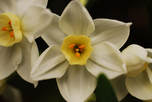 I’ve always liked flower bulbs and especially enjoy forcing them to bloom. One of the easiest bulbs to force is the Paperwhite Narcissus (Narcissus tazetta). Unlike most daffodils, this species requires no chilling to flower. To the daffodil fancier, these bulbs are called the "polyanthus group" -- literally "many flowers." All tazettas have a number of blooms at the end of the scape, not just one as seen in the common daffodil. The cultivars can be divided into three groups; the bi-colors, the doubles and the whites. The name paperwhite narcissus is best used for the white group. Ziva, a selection developed by an Israeli breeder in the 1970s, is the most common. The bulbs and foliage are typical for daffodils in general. Flowers are all white and about the size of quarter, but borne in a cluster with up to a dozen blossoms. Inside the field of six white petals sets a small white cup. The name "tazetta" in Italian means "small cup". All paperwhite narcissus have a strong fragrance, but Ziva’s is particularly strong. Many consider it too strong, a kind of musky sweetness. Paperwhite narcissus is the oldest and most widely distributed of the genus. They originated in the Mediterranean region and adjacent areas of central Asia, but were an early item of commerce. They arrived in China during the Late Sung period, about 1,000 years ago, probably introduced by Arab traders. They became intimately associated with the Chinese New Year celebrations, because they can be bloomed easily in January. Our custom of forcing paperwhite narcissus in a bowl of gravel filled with water is a Chinese custom. The Chinese name for the flower is shuixian, and translates as "water fairy". But, think of it as an assemblage of Daoist deities associated with water, not cute Tinker Bell-like fairies of Western folklore. As a symbol, the flowers are supposed to be the purveyor of great happiness. During the late Victorian period, Chinese art and style seemed quite popular. During the late 1800s the Dutch, always looking for new categories of bulb crops as fashions change, began growing the polyantha narcissus in large numbers. During the late Victorian period, Chinese art and style seemed quite popular. During the late 1800s the Dutch, always looking for new categories of bulb crops as fashions change, began growing the polyantha narcissus in large numbers. They made many introductions of new hybrids and promoted the idea of forcing these bulbs indoors in the Chinese fashion to the Victorian ladies of the day. But, with the opening of WW I, interest in tazettas waned and no new cultivars were introduced. Tazettas are commonplace in California where they are often called Chinese sacred lilies. Most of these early Chinese immigrants were from Fujian Provenance (on the mainland opposite Taiwan), which also was where the bulbs were produced for the Chinese New Years festivities. I usually don’t grow my paperwhites in gravel, but use shallow bulb pans. To create a nice display, I crowd the bulbs together in the pot, often even planting the bulbs in two layers, one atop the other. They are very responsive to temperature, but too-warm temperatures cause them to stretch. To avoid the stretch problem as much as possible, I pot my bulbs in mid- to late October and leave them on the patio. If the temperature goes below 28 degrees, I bring them in. I only bring the pots inside when they are in full bloom, at which time the stretching problem continues. If I were better organized, I would set them outside at night to reduce stretch. If they get too top heavy, cut the stems for cut flowers. Paperwhites are hardy throughout Arkansas, but because they lack winter dormancy, the leaves begin to grow in the fall. Cold winter temperatures singe the leaves, and when they bloom in the spring, the flowers are attractive but the foliage looks pretty rough. By: Gerald Klingaman, retired
Extension Horticulturist - Ornamentals Extension News - January 14, 2005 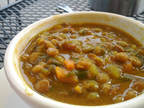 This is a good soup for a cold winter night. It does not take long to make. Makes 6 servings. Ingredients
Directions:
* Note: To toast seeds, heat a small skillet over medium heat. Add seeds. Cook about 2 minutes or until toasted and aromatic, shaking skillet frequently. Place toasted seeds into a spice grinder and process until finely ground. Source: The Sonoma Diet by Dr. Connie Gutterson, R.D., Ph.D.
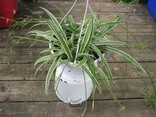 If you adhere to the Hindu notion that all life is a continuum and that the most lowly bug could possibly be an ancestor reborn, then it seems likely that Spider Plant was a cat in a previous life. They have nine lives and when you leave them alone for a while in the dark they fool around and make babies Spider plant (Chlorophytum comosum) is a member of the lily family that produces a cluster of foot-long leaves from a crown of fleshy roots. The Victorians called it "ribbon plant," because of its variegated selections. The variegated sort called Vittatum, with a wide central band of white down the center of the leaf, is most common. A variety called Variegatum has a white band down the outer margin of the leaf. Gold variegated forms are also available. In summer, spider plant produces dime-sized, six-petaled white flowers along sprawling, much-branched scapes that may reach 2 feet long. The flowers are interesting but insignificant. What makes spider plant unique, is its ability to produce "spiders," or offsets, if you prefer the horticultural term. These ready-made plants, complete with roots, form at the ends of the flower stem and assorted branches. These dangling plantlets give rise to the common name as they hang below the parent plant like so many spiders suspended by a stout web. The often heard name of Airplane Plant supposes that the plantlets look like whirling propellers. Spider plant is of South and West African origin and seems to have been introduced into Europe by the end of the 18th century, most likely by the intrepid plant explorer Carl Peter Thunberg(1743-1828). Thunberg, after whom the flowering vine Thunbergia is named, was a student of Linnaeus who traveled in South Africa during 1772 and ‘ 73 where he collected seeds, bulbs and dried plant specimens for his botanical work. Capetown was a popular resting place for ships heading home from China and passengers often took home souvenir plants on their return voyage just as we take home trinkets from our travels. Spider plant is first and foremost a hanging basket plant. It became popular as such during the Victorian period when decorative foliage plants adorned the parlor of all the finest homes. Flower scapes are produced in the summer with plantlets forming on those stems as the days get shorter in the fall. Of late, spider plant has enjoyed some use as a summer bedding plant where it is used like an annual liriope for edging flower beds. While spider plants are almost indestructible as a houseplant, they sometimes look a bit tattered and torn. The most common problem is tip burn on the leaves. This is caused by the accumulation of fluoride ions in the tissue until it reaches toxic levels. Affected plants can be cleaned up by trimming the burned tips off with scissors. Unless preventative steps are taken the problem will return. Plants of the lily family are especially sensitive to high fluoride levels and often show this kind of tip dieback. The fluoride can come from low-grade fertilizer, some vermiculite sources or tap water (for prevention of tooth decay). To remedy the problem, repot the plants in fresh potting soil, fertilize with a high grade liquid fertilizer and, if your community fluoridates its water supply, collect some rain water for this plant. By: Gerald Klingaman, retired
Extension Horticulturist - Ornamentals Extension News - February 22, 2002  Unfortunately – even though the purveyors of fast and processed food argue vehemently against the charge – our dietary situation has devolved during the last generation to the point where two-thirds of us are rated as obese. Getting back to home cooked meals using food raised in our own back yards is a laudable goal but one that still has a ways to go before much a dent is made in the way we eat. Chives (Allium schoenoparasum) is an herb that makes up a small part of our diet but is one of the foods we should probably eat more. Chives are a widely distributed member of the onion family that occurs throughout Europe and Central Asia. It is a clump-forming bulbous plant that forms slender, white, three-eighths-inch-wide bulbs that quickly form offsets and expand the size of the clump. The hollow green leaves grow about 14 inches tall and produce a mild onion flavor when eaten. Flowers appear the second spring from seeding in a terminal umbel about 16 inches tall. The individual flowers are about a half-inch inch wide with six star-shaped purple petals. Twenty to 30 flowers are combined to form the head. Each clump produces a number of showy flower heads that begin appearing in late spring and continue on and off during the rest of the season. If the flower heads are allowed to remain on the plant a number of small black seeds are produced in a three-valved capsule. This onion, unlike most of its kin, is grown for its mild flavored foliage, not its bulbs. It has been eaten for at least 5,000 years in most European countries. Looking at the translations of the word “chive” into various European languages, no commonality in word form is seen thus indicating the antiquity of the food in various cultures. The word “chive” is a Middle English word said to have been anglicized through French from the Latin word “cepa,” for onion. The Latin epitaph schoenoparasum is from Greek words and translates as “rush leek,” a reference to the round rush like leaves that taste like leek. Chives are an easily grown pot herb useful for imparting a mild onion flavor to soups, salads and broths or – as I first became acquainted with them – as an ingredient to the fully loaded baked potato. They are available year round in grocery stores or can easily be grown in a corner of the vegetable garden or planted as a border plant in the flower garden. A few clumps will keep the average family in chives all year long. They are best in full sun or light shade in average garden soil. They may be started by spring planted seed or by division of the clump at any season. Because the seedlings are small, grow the plants in a container until the transplant is large enough to move to the garden. To maintain a ready supply of greens from new growth, cut the plants back to within an inch or so of the ground. By staggering the cutback operation it will be possible to have fresh, succulent greens all season long. The bulbs are winter hardy from zone 4 through 9. By providing a protective covering during the coldest part of winter it is possible to have fresh chives year round in Arkansas. Seed heads should be removed before the seed crop has a chance to mature. By: Gerald Klingaman, retired
Retired Extension Horticulturist - Ornamentals Extension News - May 11, 2012 These are a crowd pleaser for breakfast or with tea/coffee in the afternoon. They are like little apple cakes, and freeze well if you want to make them in advance. Oven: 425 degrees Bake: 12-15 minutes Pan: Sheet Pan with silpat or parchment paper Yields: 12 scones Ingredients:
2 1/2 c. soft white flour (325 g) 1/3 c. brown sugar (73 g) 1 T. baking powder 1 tsp. cinnamon 1/2 tsp. salt 6 T. cold butter, diced (84 g) 2 c. apples peeled and chopped finely (about 2 small apples) 1/2 c. milk (120 g) 1 egg large Directions:
Icing 1/4 c. brown sugar (50 g) 2 T. butter (28 g) 1 T. milk (15 g) 1/1 c. powder sugar (60 g) 1 tsp. vanilla extract Icing Directions
Drizzle over the cooled scones, serve warm or at room temperature By Tamara Carl |
Archives
April 2022
|
|
